how to find points of discontinuity
A mathematical function has a discontinuity if it has a value or point that is undefined or discontinuous. Discontinuity is of utmost importance in mathematics. If you're studying algebra, you might be required to identify the point of discontinuity in the equation.
We'll help you figure it out by identifying the different types of discontinuity and outlining basic facts about it.
Types
Asymptotic Discontinuity
Whenever an asymptote exists, asymptotic discontinuities occur. The asymptote of a curve in analytical geometry is a line whereby the distance between the line and the curve nears zero as both of them tend to infinity. Although at one time some sources included the requirement that the curve cannot cross the line infinitely very often, most modern authors do not subscribe to this.
If you view a graph and find it approaching a point but not exactly touching that point, this is an example of asymptotic discontinuity. Furthermore, the other side of the graph has the same thing happening to it because from both sides, you never actually see the graph touch the point. This is in essence why there is a discontinuity in the graph in the first place.
As a general rule, these asymptotes exist when the function approaches infinity at a specific value of y or x. If the function has values on an asymptote's two sides, the connection is not possible, which means that it has to have a discontinuity at the asymptote. Always look for asymptotes at points that have a zero denominator because the value's function is very large when the denominator gets close to zero because it becomes very small.
If you look at the fraction  , you can divide 5 by 0.1 and get 50. If the denominator is made smaller, the fraction's value becomes larger; for example,
, you can divide 5 by 0.1 and get 50. If the denominator is made smaller, the fraction's value becomes larger; for example, ![]() = 500,
= 500, ![]() = 500000. This means that the closer the denominator gets to zero, the larger the fraction's value. This is demonstrated by
= 500000. This means that the closer the denominator gets to zero, the larger the fraction's value. This is demonstrated by ![]() .
.
Endpoint Discontinuities
If a function is described to have a closed endpoint on its interval, it is called an endpoint discontinuity. The limit cannot exist at the endpoint, however, because the limit needs to view function values as xx approaches from both of its sizes. In other words, considering finding limx→0x−−√limx→0x (see the following graph).
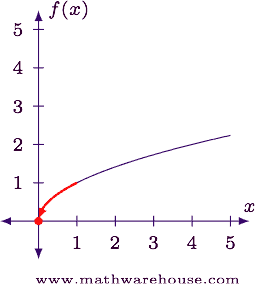
In the above example, x=0x=0 is the left endpoint of the domain's functions; i.e., [0,∞)[0,∞), and technically, the function isn't continuous at that point because the limit doesn't really exist. This is because xx cannot approach from the two sides.
One more thing: the function is right-hand continuous at the x=0x=0 so there are no jumps or holes at the endpoint.
Infinite Discontinuity
Also called essential discontinuity, this occurs when you look at the domain of function and at some point, both the upper and lower limits or just one of them do not exist. It exists when one of the function's one-sided limits is infinite; i.e., lim x → c + f ( x ) = ∞ or one of the other three varieties of the infinite limits. If the other two one-sided limits have equal values, the two-sided limit also exists.
The univariate real-valued function ![]() is thought to have an infinite discontinuity at its domain point
is thought to have an infinite discontinuity at its domain point ![]() if either or both of the upper and lower limits of
if either or both of the upper and lower limits of ![]() fail to exist as
fail to exist as ![]() tends to
tends to ![]() . These are often referred to as essential discontinuities and indicate that points of discontinuity tend to be more severe than other types of discontinuities, such as jump or removable discontinuities.
. These are often referred to as essential discontinuities and indicate that points of discontinuity tend to be more severe than other types of discontinuities, such as jump or removable discontinuities.
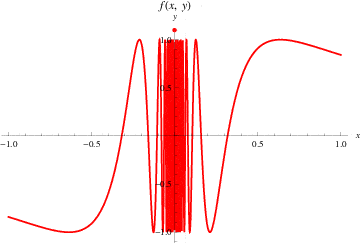
The figure above is an example of the piecewise function,
 |
a function for which both ![]() and
and ![]() fail to exist. In particular,
fail to exist. In particular, ![]() has an infinite discontinuity at
has an infinite discontinuity at ![]() .
.

Jump Discontinuity
Similar to point discontinuities, jump discontinuities exist when entire portions of the curve jump instead of a normal curve having a single-point "jumping" action. When the function has finite but unequal limits, the points from the left and from the right are approached by the independent variable. Jump discontinuities occur when the function starts to jump between the different points in the graph.
The univariate function ![]() contains a jump discontinuity at its domain's point as long as
contains a jump discontinuity at its domain's point as long as
Don't confuse jump discontinuity with situations whereby the term "jump" is meant to describe any type of functional discontinuity as they are two separate things.
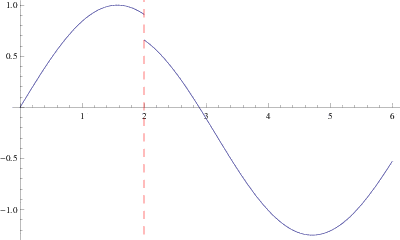
The figure above is a good example of a function with a jump discontinuity at some point in its domain.
In general, jump discontinuities are much less ill-behaved than singularities of other types, such as infinite discontinuities. Many scenarios exemplify this, including the fact that univariate monotone functions can have many discontinuities including the worst one, which can be the jump discontinuity.
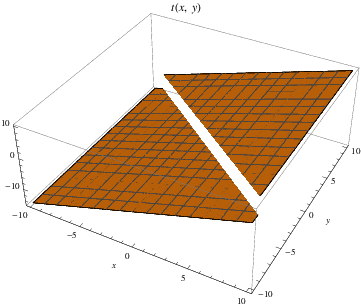
You can generalize the definition above and include jump discontinuities in real-valued multivariate functions too. As an example, the function displayed in this figure demonstrates the piecewise function,
| |
a monotone function in each ![]() and
and ![]() separately and includes jump discontinuity on the entire line
separately and includes jump discontinuity on the entire line ![]() .
.
Mixed Discontinuity
When you consider this graph:

The function is discontinuous at x=3x=3. If you start from the left, you'll see that the function's discontinuity is infinite but the one on the right has a removable discontinuity. Because there are various reasons why the discontinuity exists, it is called a mixed discontinuity.
Oscillating Discontinuity
Oscillating discontinuities exist when the function's values seem to be nearing two or more values at the same time. The function f(x)=sin(1x)f(x)=sin(1x) demonstrates this. Situations that qualify as an oscillating discontinuity include:
- In a removable discontinuity, whatever the distance that the function's value is off by is the oscillation
- In a jump discontinuity, the jump's size is the actual oscillation, provided that the value at the point is between these limits from the two sides
- In an essential discontinuity, the failure of a limit to exist is measured by the oscillation
In certain unique cases when the function diverges to or minus infinity, the oscillation will not be defined; in real numbers that are extended, this is called a removable discontinuity.
Point Discontinuity
When piecewise functions experience a specific value for x that is defined somewhat differently than the rest of that piecewise function, point discontinuities can exist. Points of discontinuity are also called removable discontinuities and include functions that are undefined and appear as a hole or break in the graph. Points of discontinuities are created whenever the function is in fraction form and a variable that is inputted creates a denominator that equals zero.
To find the point of a discontinuity, factor the function's denominator and numerator. The point of discontinuity exists when a number is a zero of both the denominator and the numerator. The point of discontinuity is there because both the numerator and denominator are zero. If you wish to find the value, simply plug in the simplified final equation.
Removable Discontinuity
Removable discontinuity occurs when the function and the point are isolated. Essentially, a removable discontinuity is a point on a graph that doesn't fit the rest of the graph or is undefined. Removable discontinuities are removed one of two ways: either by defining a blip in the function or by a function that has a common factor or hole in both its denominator and numerator.
For a univariate, real-valued function ![]() to have a removable discontinuity at a point
to have a removable discontinuity at a point ![]() in its domain, both
in its domain, both ![]() and
and ![]() have to exist while
have to exist while ![]() . The reason why removable discontinuities are called this is because you can "remove" this discontinuity point by defining an identical function
. The reason why removable discontinuities are called this is because you can "remove" this discontinuity point by defining an identical function ![]() of the form,
of the form,
![]()
which is necessarily everywhere – continuous.
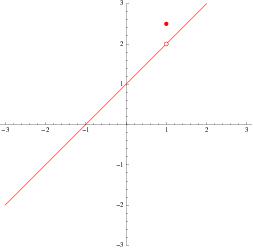
The figure above demonstrates the piecewise function,
 |
a function for which ![]() while
while ![]() . Indeed,
. Indeed, ![]() has a removable discontinuity at
has a removable discontinuity at ![]() because defining a function
because defining a function ![]() as discussed above and satisfying
as discussed above and satisfying ![]() would result in an everywhere – continuous version of
would result in an everywhere – continuous version of ![]() .
.
Of course, this definition of removable discontinuity doesn't apply to functions ![]() for which and fail to exist; in particular, this definition only allows for one way to talk about a function being discontinuous at the points for which it is defined. The definition is also not uniform and since this is so, some authors say that, for example, has a removable discontinuity at the point. This is related to the so-called sinc function.
for which and fail to exist; in particular, this definition only allows for one way to talk about a function being discontinuous at the points for which it is defined. The definition is also not uniform and since this is so, some authors say that, for example, has a removable discontinuity at the point. This is related to the so-called sinc function.
When it comes to real-valued univariate functions, removable discontinuities are thought to be "less severe" than infinite or jump discontinuities. Obviously, you can apply the definition above so as to allow removable discontinuities' descriptions for multivariate functions too. In addition, removable discontinuities are related very strongly to the idea of removable singularities.
Practical Examples
| f(x)=x1 | Discontinuity at x=0 | |
| f(x)=x−3x2−9 | Removable Discontinuity at x=3 | |
| f(x)=x2 1x+1x0x=0x0 | Discontinuity at x=0 | |
| f(x)=1 3x0x0 | Jump Discontinuity at x=0 | |
| f(x)=sinx1 | Discontinuity at x=0 |
The Basics of Discontinuation
General Explanation
Essentially, a continuous function is a function on a graph consisting of a continuous curve. In other words, if you take your pencil and try to draw the curve, the pencil never leaves the paper until the function is completed. For obvious reasons, the opposite is called a discontinuous function.
In a discontinuity, the points are isolated from one another on your graph, which means that you have to lift your pencil at least once before the graph is complete. If any type of break happens, even at just one of the points, it is a discontinuous function. Below, you can see the difference between a continuous and discontinuous function.
Properties
In this example, the function that is discontinuous stops where x equals 1 and y equals 2. It picks up again where x equals 1 and y equals 4.
There are many properties that are specific to functions that are discontinuous and two of the most important ones include:
- In all instances, the function breaks off at either a specific point or at multiple points. Discontinuous functions always have points at the part of the graph that stops and they pick up in another location.
- The function's limit at a discontinuous point, in most discontinuous functions, is undefined. This is not true in all cases and the limit itself can be defined; however, it is still classified as discontinuous.
How to Tell If a Function Is Continuous or Discontinuous
If you ever took pre-calculus, you already know that functions which are not continuous at an x value have one of two types of discontinuity: a removable discontinuity, which is demonstrated by a hold in the function's graph; or a non-removable discontinuity, which is demonstrated by an asymptote or a jump in your graph.
If the bottom term cancels and the function factors, the discontinuity found at the x-value for which zero was that the denominator is removable, which means that the graph shows a hole in it. An example of a function that factors is demonstrated below:
After the cancellation, you have x – 7. Because of this, x + 3 = 0, or x = -3 is an example of a removable discontinuity. This is because the graph has a hole in it.
After canceling, it leaves you with x – 7. Therefore x + 3 = 0 (or x = –3) is a removable discontinuity: the graph has a hole, which you can see in Figure A.
An easy way to remember it is this: a removable discontinuity makes you feel empty but the graph that contains a non-removable discontinuity makes you feel happy.
If the term doesn't cancel, the discontinuity located at this x-value that corresponds to this term for which zero is the denominator and is non-removable; the graph will have a vertical asymptote.
The following function factors this way:
This is because when the x + 1 cancels, you get a removable discontinuity at x = -1. This means that you would see that the graph has a hole there instead of an asymptote. However, since the x – 6 didn't cancel in the denominator, there is a nonremovable discontinuity at x = 6. This discontinuity causes a vertical asymptote at x = 6 in the graph. Figure B demonstrates the graph of g(x).
how to find points of discontinuity
Source: https://www.popoptiq.com/types-of-discontinuity/
Posted by: harrisonwitinithey.blogspot.com

0 Response to "how to find points of discontinuity"
Post a Comment